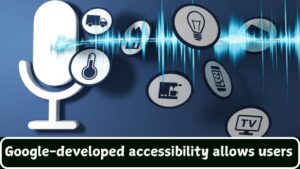Google-developed accessibility tool that allows users
Voice Access is a Google-developed accessibility tool that allows users to control their Android devices hands-free using voice commands. Designed primarily for individuals with motor impairments, this feature is also beneficial for those looking for a hands-free solution to navigate their devices efficiently. It enables users to perform various tasks such as opening apps, managing device settings, and editing text—all through simple voice instructions.

1. Introduction to Voice Access
Voice Access aims to provide an intuitive way to control Android devices without touching the screen. It caters to people with limited dexterity or physical disabilities, helping them interact with their devices more easily. However, the hands-free capability also appeals to users who want to multitask or avoid manual interaction, such as drivers or busy professionals. Voice Access leverages Google’s natural language processing (NLP) technology to recognize commands in conversational language, making it user-friendly.
2. Key Features of Voice Access
Voice Access is packed with features that offer comprehensive control over a device’s functions:
- Hands-Free Navigation: Users can open apps, select items, and perform actions by issuing voice commands. Elements on the screen are numbered, so users can say “Tap 5” or refer to buttons by name.
- Text Dictation and Editing: Voice Access supports dictation in any text field. Commands such as “Delete,” “Select,” and “Replace” enable users to edit their dictated text efficiently.
- Control of Device Settings: Users can adjust settings like brightness and volume with simple commands, making device management accessible to those who find it difficult to interact with the settings menu.
- Gesture Control: Commands such as “Swipe up,” “Scroll down,” or “Go back” allow users to navigate apps and pages without physically interacting with the device.
- Contextual Commands: Voice Access understands commands based on the current app context, allowing users to speak naturally without specifying detailed instructions.
- Custom Shortcuts: Users can create custom commands to simplify frequent actions, further enhancing the personalization of the experience.
3. Use Cases for Voice Access
Voice Access is a versatile tool with several key use cases:
- For People with Physical Disabilities: It offers individuals with conditions like spinal cord injuries, multiple sclerosis, or arthritis the ability to manage their devices independently, significantly enhancing accessibility.
- For Multitasking Professionals: Professionals with busy hands, such as healthcare workers, can use Voice Access to check emails, send messages, or browse information while continuing other tasks.
- For Drivers: Voice Access enables drivers to operate their phones safely while driving, performing tasks such as making calls or sending texts without taking their hands off the wheel.
- For the Elderly: Older adults who may find touchscreens challenging can use Voice Access for simplified navigation, staying connected to family and friends or accessing emergency services.
4. Setting Up Voice Access
Setting up Voice Access is simple. Users can download the app from the Google Play Store and activate it through the Accessibility settings on their device. Voice Access can be enabled using a shortcut or by saying “Hey Google, start Voice Access.” Users can also customize settings such as the language for voice commands and whether numbers are displayed on the screen elements.
5. Practical Applications
Voice Access can be used in everyday scenarios like:
- Messaging: Users can dictate and edit texts and emails using voice commands like “Send message” or “Select all.”
- Browsing the Web: Commands like “Scroll down” or “Click link” enable users to browse websites easily.
- App Management: Users can switch between apps, open or close them, and control media without tapping the screen.
- Device Control: Tasks like adjusting the volume, turning on Wi-Fi, or making phone calls are possible through voice commands.
6. Troubleshooting and Best Practices
Users may encounter issues such as voice commands not being recognized or slow response times. To resolve these problems, they should ensure they’re speaking clearly, check for microphone obstructions, or free up system resources by closing background apps. For the best experience, users should regularly update the app, familiarize themselves with key commands, and consider using a headset for clearer voice recognition.
Conclusion
Voice Access is a vital tool that improves accessibility for individuals with disabilities while offering convenience for all users seeking hands-free device control. By leveraging voice commands, it allows users to navigate apps, manage settings, dictate text, and perform various tasks with ease, enhancing both independence and productivity.
